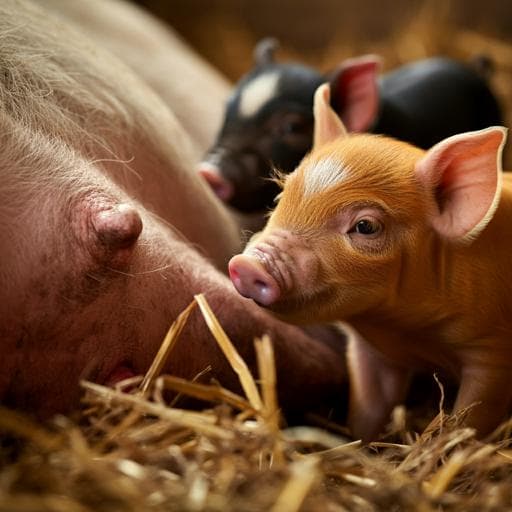
Veterinary Science
A cross-specific multiplicative binomial recursive model for the analysis of perinatal mortality in a diallel cross among three varieties of Iberian pig
L. Varona, J. L. Noguera, et al.
This groundbreaking study on perinatal piglet mortality reveals critical insights into the relationship between litter size and stillbirth rates. Conducted by esteemed researchers Luis Varona and his colleagues, it offers innovative modeling techniques to address important concerns in pig production and animal welfare.
~3 min • Beginner • English
Introduction
Perinatal piglet mortality is a major challenge in pig production and is difficult to analyze statistically due to the categorical and zero-inflated nature of the number of stillborns (SB). Prior work indicates that modeling piglet survival with a binomial distribution and logit link at the piglet level is appropriate. However, non-Gaussian models struggle to incorporate non-genetic relationships among traits. A strong, sometimes non-linear, phenotypic relationship exists between litter size (Total Number Born, TNB) and SB. Recursive models are suitable to represent the causal/phenotypic dependence because TNB is largely determined before farrowing, whereas most stillbirths occur around farrowing, making it reasonable to model SB as phenotypically dependent on TNB. The standard recursive model assumes a common dependence across all data, but genetic and environmental factors may cause this dependence to vary among groups (e.g., crosses). Additionally, SB may be over- or under-dispersed relative to the binomial assumption. The multiplicative binomial (MBN) distribution generalizes the binomial to accommodate dispersion via an extra parameter. The objective was to develop a recursive model allowing cross-specific recursive functions and to replace the binomial with the MBN distribution, applying this to TNB and SB in a full diallel among three Iberian pig varieties (EE, RR, TT). The model allowed up to nine cross-specific recursive relationships and reparameterized estimates to Dickerson’s direct, maternal, and heterosis effects.
Literature Review
Previous studies compared probabilistic models for piglet mortality and found a binomial-logit model at the piglet level to be suitable, while acknowledging challenges in modeling non-genetic trait relationships. Extensive literature documents a strong and sometimes non-linear relationship between litter size and piglet mortality, with factors such as farrowing duration, hypoxia risk, litter weight, and average piglet weight implicated. Recursive models have been proposed to handle phenotypic dependencies between traits measured at different biological stages. Overdispersion relative to the binomial is common because Bernoulli events within litters are not independent due to shared biological and environmental causes; the multiplicative binomial distribution has been proposed to handle such dispersion. Diallel cross analyses and Dickerson’s model provide a framework to separate direct, maternal, and heterosis effects relevant to litter traits in pigs, including Iberian populations.
Methodology
Animals and data: 10,255 farrowing records from 2,110 sows in a full diallel cross among three Iberian pig varieties—Entrepelado (EE), Retinto (RR), Torbiscal (TT)—and their reciprocals (ER, ET, RE, RT, TE, TR) were analyzed. Sows were on a commercial farm and mated to Duroc boars. SB was recorded as the count of piglets born dead; TNB recorded total born. Data distribution by cross included: EE 433, ER 2336, ET 942, RE 806, RR 870, RT 2450, TE 193, TR 1993, TT 232 records. Mean (SD): TNB 8.46 (2.27), SB 0.25 (0.72). Pedigree extended three generations (4609 individuals). Founders: 47 EE, 80 RR, 107 TT.
Response distributions: For each litter i, SB yi|ti,φi,θ ~ MBN(yi | nb=ti, φi, θ), the multiplicative binomial distribution with parameters φi (0–1) and θ (>0) governing dispersion. θ=1 recovers binomial; θ<1 implies overdispersion; θ>1 underdispersion. The Bernoulli event probability under MBN depends on φ and θ via ratios of K-functions as defined in the paper.
Model for TNB: ti = X b + Z u + Z p + e, with systematic effects b: cross (9 levels), parity order (6 levels), year-season (30 levels); u additive genetic effects (4609 levels); p dam permanent environmental effects (2110 levels); e Gaussian residuals.
Model for logit(φ): Five alternative specifications tested:
- Model I: logit(φi) = X b1 + Z u1 + Z p1 (no recursion).
- Model II: adds linear recursive dependence on deviation of litter size from the overall mean within cross and parity: logit(φ) = X b1 + Z u1 + Z p1 + λ1 d.
- Model III: adds quadratic term: logit(φ) = X b1 + Z u1 + Z p1 + λ1 d + λ2 d^2.
- Model IV: cross-specific linear recursion: logit(φ) = X b1 + Z u1 + Z p1 + Σk λ1k wk, where wk is the deviation d for cross k, 0 otherwise.
- Model V: cross-specific linear and quadratic recursion: logit(φ) = X b1 + Z u1 + Z p1 + Σk λ1k wk + Σk λ2k wk^2.
θ was common to all litters.
Priors: Additive genetic and permanent environmental effects jointly for TNB and logit(φ) followed multivariate normal distributions with A⊗G and I⊗P covariance structures, respectively, where G and P are 2×2 matrices with variances (σa^2, σp^2 for logit φ and TNB) and covariances (σap for additive, σpt for permanent environment). Systematic effects and variance components had uniform priors within bounds. Residual variance σ^2 for TNB had an appropriate prior.
Inference: Hierarchical Bayesian analysis via Gibbs sampling with a Metropolis-Hastings step for logit(φ). One chain of 550,000 iterations with 50,000 burn-in. Convergence checked visually and with CODA in R. Posterior marginal distributions obtained for all unknowns, including θ.
Dickerson parameters: At each MCMC iteration, cross effects were linearly reparameterized to obtain direct (LE, LR, LT), maternal (ME, MR, MT), and heterosis (HER, HET, HRT) effects for both TNB and logit(φ) by solving the provided linear system.
Model comparison: Models compared using the sum of log conditional predictive ordinates (LogCPO); higher LogCPO indicates better predictive fit. Monte Carlo approximation computed from posterior draws.
Ethics: Approved by IRTA’s animal ethics committee, compliant with Spanish RD1201/05 and EU Directive 86/609.
Key Findings
- Best model: Model II (linear recursion between TNB deviation and logit(φ)) had the highest LogCPO. The advantage over a non-recursive model (Model I) was substantial (difference of 302.92 LogCPO units), indicating better capture of non-genetic dependence.
- Recursive slope: Posterior mean λ1 = 0.257 logit units per additional piglet (SD 0.007), implying increased probability of stillbirth with larger litters.
- Nonlinearity and cross-specific recursion: Models with quadratic terms and cross-specific recursion (III, IV, V) did not show meaningful improvement in LogCPO (differences within ~18 units compared to Model II), providing no strong evidence for nonlinearity or cross-heterogeneity in the recursive relationship.
- Overdispersion: θ posterior means ranged from 0.816 (Model II) to 0.892 (Model I), all significantly below 1, indicating strong overdispersion and supporting use of the MBN over the standard binomial.
- Variance components (Model II): For TNB, additive genetic variance 0.397 (SD 0.090), permanent environmental variance 0.368 (0.080), residual variance 4.497 (0.071). For logit(φ), additive genetic variance 0.050 (0.044), permanent environmental variance 0.418 (0.056), indicating low additive genetic but substantial permanent environmental variation affecting stillbirth propensity.
- Correlations: Under recursive models (II–V), genetic and permanent environmental correlations between TNB and logit(φ) were small and their 95% HPD included zero (genetic ~0.203–0.238; permanent ~0.022–0.031). In the non-recursive model (I), correlations were positive (~0.51), likely compensating for unmodeled residual dependence.
- Cross effects (Model II): For TNB, RE and TE crosses were above average by 0.526 (0.128) and 0.401 (0.214) piglets, respectively; TT was below average by -0.982 (0.209). Dickerson reparameterization: direct effects ranged from -0.391 (Torbiscal) to 0.492 (Retinto); maternal effects from -0.193 (Torbiscal) to 0.282 (Entrepelado). Heterosis for TNB was positive: ER 0.532 (0.109), ET 0.681 (0.169), RT 0.584 (0.118).
- For logit(φ) at mean TNB, cross intercepts varied: TR -0.196 (0.080), ET -0.143 (0.095), ER -0.135 (0.709); EE 0.237 (0.122), TE 0.136 (0.166). Dickerson maternal effects indicated EE-origin dams had higher stillbirth propensity (ME 0.150 (0.077)), whereas RR-origin dams reduced it (MR -0.120 (0.047)). Direct effects small (e.g., LT -0.051 (0.159) to LR 0.069 (0.112)).
- Heterosis for stillbirth propensity: Negative heterosis effects on logit(φ) indicating reduced probability of stillbirth in crossbred sows; magnitudes approximately ER -0.196 (0.091), ET -0.130 (0.147), RT negative as well, with posterior probabilities of being negative 98.34%, 81.05%, and 90.14%, respectively.
Discussion
Allowing a linear recursive dependence of stillbirth propensity on litter size markedly improved predictive fit, showing that non-genetic phenotypic relationships between traits can and should be modeled explicitly in non-Gaussian frameworks. The positive recursive slope aligns with biological expectations: larger litters are associated with prolonged farrowing, increased hypoxia risk, and altered litter/piglet weight distributions, all elevating stillbirth risk. While more complex, cross-specific or quadratic recursive structures were explored, the data did not support substantial departures from a common linear effect, and model comparison favored parsimony (Occam’s razor). The strong overdispersion (θ<1) confirms dependence among piglet survival outcomes within litters, validating use of the multiplicative binomial distribution. Genetic variance for TNB was moderate, consistent with prior Iberian and white pig studies, whereas additive genetic variance for stillbirth propensity was low and permanent environmental effects large, emphasizing management and sow-level factors. Maternal line effects suggested EE maternal origin increased stillbirth propensity and RR maternal origin reduced it. Importantly, maternal heterosis improved piglet survival (reduced stillbirth probability), complementing known heterosis effects on litter size. Together, these findings support breeding and crossbreeding strategies that exploit heterosis to counterbalance increased mortality risk associated with larger litters, while recognizing the primacy of management and permanent environmental influences.
Conclusion
The multiplicative binomial distribution is a useful alternative to the standard binomial for perinatal mortality data exhibiting overdispersion. Recursive models effectively capture non-genetic phenotypic relationships between traits; a simple linear dependence of stillbirth propensity on litter size provided the best fit. In Iberian pigs, stillbirth risk increases with litter size, but maternal heterosis reduces stillbirth probability, indicating value in producing crossbred sows. Future work could explore more flexible non-linear recursive structures (e.g., change-point models) and assess scenarios with cross- or environment-specific recursive effects.
Limitations
- Cross effects were modeled as independent a priori despite genetic links among sows across crosses, introducing potential confounding between additive genetic and cross effects. Inclusion of additive genetic effects aimed to account for relationships, but ideal inference would use unrelated observations across crosses, which was not feasible.
- The recursive specification was limited to linear and quadratic forms; more flexible non-linear or change-point relationships may better capture complex dependencies.
- The dispersion parameter θ was assumed common across all litters; heterogeneity in dispersion by cross or environment was not modeled.
- Estimates of additive variances for stillbirth propensity were low and should be interpreted cautiously given the multi-population structure and potential confounding.
- The modeling framework used Bayesian MCMC; alternative likelihood-based approaches (e.g., EM) were not evaluated here and could provide complementary inference.
Related Publications
Explore these studies to deepen your understanding of the subject.







